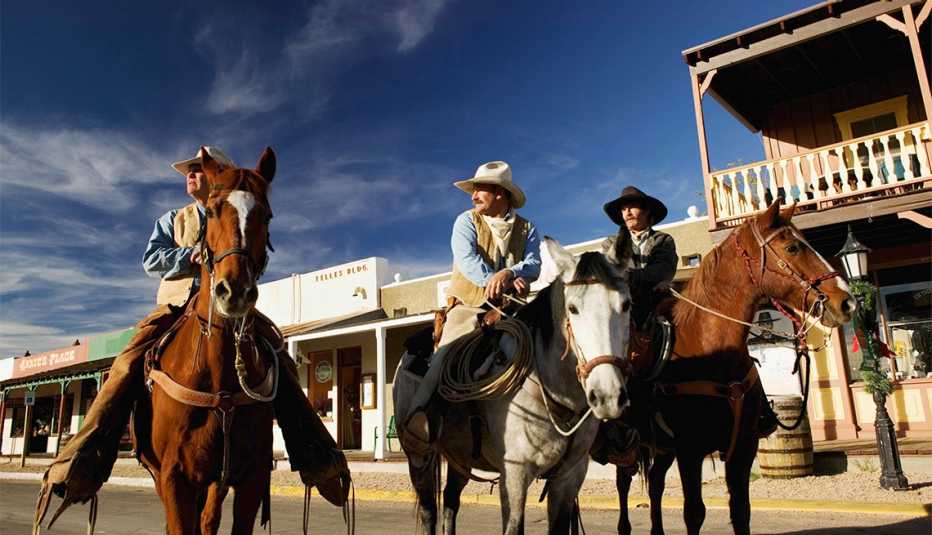AARP Hearing Center
The Southwest shines in this 450-mile route through the saguaro-studded desert up into high mountains, where rare birds flit and spectacular sunsets give way to dark skies spangled by stars. Tucson anchors this tour, rich in history and redolent with the scents of great food and local wines. You might consider adding a day to the beginning of the trip to explore Saguaro National Park, whose two entrances are each only about 20 minutes from downtown Tucson.
Day 1: San Xavier del Bac and Tumacácori (57 miles)


- How to plan an epic road trip
- Explore Southern Arizona
- Experience California's Highway 1
- South Carolina adventure
- Scenic Hells Canyon in Oregon
- Washington's San Juan Islands
- Michigan coast
- Art in the Hudson Valley
- Unique Southwest hotels
- Road trip quiz
- Money-saving tips
- 8 travel pros' trip ideas
- Travel news and vacation ideas
Explore Southwestern history today on visits to two Spanish colonial missions, and enjoy the chance to stock up on spices. En route, you’ll encounter dramatic mountain vistas.
From Tucson, head south on Interstate 19 for 8 miles, then take exit 92 for San Xavier del Bac Mission. (Note that local authorities ask drivers not to pull onto the verge during dry spells to take photos. Your car’s hot undercarriage could ignite dry grass and shrubs.) The Catholic Church has been active on these Indigenous Tohono O’odham lands since 1692, and this dramatic, sugar-white church with a masonry vault roof was completed 105 years later. While soaking up the Baroque architecture, look for shell-shaped details honoring Spain’s patron saint, Santiago.
Drive south on I-19 another 39 miles to the serene Tumacácori National Historical Park. Indigenous peoples — including the Nde, O’odham and Yoeme — frequented this lush area along the Santa Cruz River for generations. The Spanish arrived in the 1690s, establishing the first mission in what is now Arizona. Explore the evocative grounds, where many adobe structures have melted back into the earth. Enter the striking ruins of an early 19th-century church, then wander an old orchard and replica walled garden. Stay alert for opportunities to return to this International Dark Sky Park at night. Rangers periodically lead stargazing and astrophotography sessions, as well as full-moon hikes.
Continue on I-19 by car, but pause just one-third of a mile down the road at the Santa Cruz Chili & Spice Company. A Bryn Mawr graduate and her cowboy husband started this business in 1943, repurposing World War II equipment to pressure-cook and then grind dried chile pods. The wonderfully fragrant store sells everything from adobo to whole sage leaves. Don’t miss the house-made hot sauces, which add jalapeños, green chiles and spices to a tomato base.
Backtrack north 4 miles on I-19 to the artsy town of Tubac for dinner at Elvira’s, which serves contemporary Mexican dishes in a chic dining room. A favorite: the hazelnut mole.
Tip: Be prepared to stop at temporary checkpoints within 100 miles of the Mexican border. On I-19, watch for distance signs in kilometers (rather than miles), completed in 1978 during America’s attempt at shifting to the metric system. Arizona planned to replace the signage three decades later, but citizens insisted the quirk be maintained.
Where to stay: Tubac Secret Garden Inn, a half mile east of Elvira’s, features Spanish-style architecture. Groups can rent a casa or suite, but the property also has rooms with terra-cotta tile floors and pops of Southwestern color.


Day 2: Tombstone and Bisbee (124 miles)
Start on a “sky island” — one of the area’s isolated mountaintops that steeply rise above the desert’s daytime heat, nighttime chill and overall harsh, dry conditions. Fifty-five of these peaks form the Madrean Archipelago, stretching from Mexico into the Southwest and featuring some of the planet’s richest biodiversity.





































































